

Cable Street Directory 1921
The
small traders in the street, and some of the larger ones, were mainly
Jewish, with a sprinkling of Irish (and a pork butcher!) Notes below
provide some detail of the larger companies, and of a few individuals. The transcription is partly based on this excellent website.
| North Side 1 Morris Gellman & Sons, walking stick manufacturers [1] 3 Jacob Nyman, tin plate worker 5 Davis Goldstein, ladies tailor 7 Mrs Minnie Levenberg, greengrocer 9 Thomas Edward Deeks, draper 11 Abraham Markovitch, butcher 17 Joseph Wanscofsky, boot repairer 19 Victor Emanuel, fishmonger 23 Harris Druian, secondhand clothier [2] 25 Jacob Rodinsky, furniture broker 27 Mrs Annie Mason, stationer 31 Sun & Sword, Edward White [3] ... here is Backchurch Lane ... 33 Isaac Shulman, wardrobe dealer 35 Israel Schwartz, watch maker 39 George Farnham, rag merchant 41 Joseph Margelafsky, chandlers shop 43 Mrs Florence Gratton, coffee rooms 45 Davis Bialick, tailor 47 David Levy, china dealer 49 Joseph Bernstein, furniture dealer 57 Enoch Harris, tailor 65 Simon Abrahams, tailor 69 Lazarus Goldstein, tobacconist 75 Harris Greenbaum, boot repairer 79 Samuel Simpkin, boot repairer 81 Joseph Abrahams, tailor 83 F G Walker & Co, bag merchants 85 Lambert & Son, chicory importers 87 Nunn, Ridsdale & Co Ltd, ships lamp manufacturers [4] 87 T Squire, sail maker 91 Simon Marchinsky, clothes salesman 93 Mrs Rachel Stone, tobacconist 95 Abraham Glass, incandescent fittings dealer 99 Jacob Medjebowsky, laundry 101 Samuel Wassersug, cinematograph theatre [5] 111 Gadaliah Hertz, baker 113 Sam Freedman, boot maker ... here is Christian Street ... 115 Samuel Lesses, chandlers shop 117 Morris Marder, confectioner ... here is Grove Street ... Charrington, Dale & Co, coal merchants (GER coal depot) [6] ... here is Cannon Street Road ... 169 James Steadman, oilman 181 Harris Pepperberg, costume maker [7] ... here is Walburgh Street ... 201A Tobias Rosenberg, boot repairer ... here is Anthony Street ... 209-213 Sly, Dibble & Co Ltd, tent & marquee makers [8] 215 St Georges & Wapping Constitutional Club, William Titshall, secretary [9] 219 Morris Kaplinsky & Co, horn handle makers [1] 223 Benjamin Gurner Jones, vaccination officer [10] 229 & 231 John Gibbs, builder [10a] [235 former Liberal working men's club] [10b] 245 Mrs Jane Isaacs, feather dresser 263 Rosner & Osner, tailors [formerly Salvation Army] 265 Mrs Yetta Freeman, fried fish shop 267 Simon Goorwitz, tailor ... here is Watney Street ... |
South Side 2 Miss Mary Ann Withers, stationer 2 Post, Telegraph & Money Order Office & Savings Bank [11] 4 Charles Arnold, outfitter 6 Missions to Seamen Institute [12] 8 Barnett Bomzer, tobacconist [13] 10 Horns & Horseshoe, Abraham Arthur Harris [14] 12 Joseph Soll, wardrobe dealer ... here is Well Street ... 16 Charles Dawe, cheesemonger 18 Isaac Taubler, hairdresser 20 Mrs Mary Ann Burholt, baker 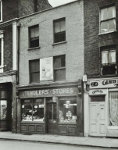 22 Thomas Milbank Hasler, pork butcher
22 Thomas Milbank Hasler, pork butcher24 Mrs Leah Barnett, outfitter [22 & 24 in 1963, right] 26 Bricklayers Arms, Walter Charles Rutter [15] 28 Barnet Rabinowitch, boot maker 30 Wilfred Kenney, grocer 32 Harry Lacombe, fried fish shop 34 Mrs Catherine Bell, oilshop 36 (& 132) Berard Nordheim, baker [16] 38 executors of Frederick Tarrant, pawnbroker 40 Samuel Julius & Walter Rose, hairdressers 42 George Green, corn dealer 44 Lewis Hammer, boot repairer 46 Michael Abrahams, dairy 48 Miss Sarah Beland, cats meat dealer 50 Abraham Rudoff, tailor 52 Harris Spivack, mantle maker 54 Simon Soffert, boot repairer 56 Blakeney's Head, Edward Alex Cornish [17] ... here is Shorter Street ... 58 Julius Cohen, haberdasher 60 Abraham Sugar, grindery dealer [18] 62 Simon Goldstein, tailor 64 Myer Cohen, cap maker [19] 68 Reuben Feldman, dairy 72 Alec Goodman, greengrocer 74 Israel Ruben, picture frame maker 76 Sam Miller, boot repairer 78 Harris Berlock, chandlers shop 80 Blue Anchor, Mrs Ann C Munford [20] .. here is North East Passage ... 82 Isaac Levy, fried fish shop 84 Samuel Yass, wardrobe dealer 86 Alick Morris, baker 88 Patrick Shea, chandlers shop 92 James William Gilmore, undertaker 94 Novsahetz Marks, boot maker 96 Louis Prefer, tailor ... here is Pell Street ... 98 Magpie & Stump, Miss Sarah Jacobs [21] 100 Woolf Salinsky, wardrobe dealer 100 Max Gilbert, tailor 102 Abraham Danzegar, cap maker [19] 104 Michael Davis, tailor 106 Mrs Sarah Schneider, dress maker 108 Charles Cohen, butcher 110 Hyman Kupferberg, chandlers shop 112 Samuel Jacobs, greengrocer ... here is Princes Square ... |
114 Aaron Hart, hairdresser 116 Harry Benjamin, chandlers shop 118 Hyman Hydleman, tobacconist 120 Harry House, hairdresser 122 George Wicks, coffee rooms 124 Abraham Ginsberg, boot repairer 126 Samuel Greenman, greengrocer [22] 132 (& 36) Bernard Nordheim, baker [16] 134 Joseph Cohen, coffee rooms 136 Philip Rinder, tobacconist 138 Levy Spielberg, chandlers shop 144 William English & Son, undertakers [23] 146 Jacob Mincer, tailor ... here is Betts Street ... Bonallack & Sons, motor engineers [24] 170 James Cliffin, boot maker 172 Crown, Frederick Edward Finch ... here is Denmark Street ... 174 Philip Isenstein, tailor 176 Michael Cohen, gasfitter 178 Joe Caplan, tobacconist 180 Francis Samuel Slater, coffee rooms 182 Woolf Silverstone, tailor 186 Fred Flatau, baker [25] ... here is Cannon Street Road ... 190 Morris Feldman, confectioner 198 East London Nursing Society, Miss Agnes M C Burkitt, matron [26] 200 Chapman Estate Office [27] 212 Mrs Matilda Deppe & Sons, carmen [28] 214 George Owen, sealing wax maker [29] 216 Samuel Katanka, manufacturing clothier 218 Charles Barratt, registrar of births & deaths 220 Jewish Infants Welfare Centre, Mrs H Irwell, honorary secretary [30] 228 Albion Mills Co, rag merchants [31] 230 Samuel Stein, furrier 232 Britannia, Israel Wasserman [32] ... here is Prospect Place ... 236 Borough of Stepney Public Libraries (St George in the East Library) Town Hall, James Evans, hall keeper & mace bearer Borough of Stepney Rate Collectors Office: collectors William George Cue,Charles Edward Cundick, James Thomas Godwin, Charles Ernest Saunders Borough of Stepney Museum (Nature Study branch) (St Georges recreation ground) St Georges Chapel (Wesleyan East End Mission) 242 & 244 W Paros, india rubber waste merchant ... the East London Railway passes here ... ... here is Dellow Street ... |

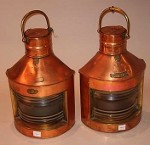 [4] Joseph and Alfred Ridsdale, brassworkers,
took George Charles Spurgin, from Helensburgh, into their partnership
at 54 Minories in 1874 until his retirement. They later traded as as
Binko, Ridsdale & Co Ltd., nautical and general lamp manufacturers,
having merged with Binko & Co, electricians and lampmakers, and from 1899 as Nunn, Ridsdale & Co.
(taking G.H. Gibson into partnership), still from the Minories address
with works at 'Shadwell' (which presumably means the Cable Street premises).
They advertised in the Marine Engineer & Naval Architect (1900) as manufacturers
of every description of ship's lamps, lanterns, fog horns, ship
fittings, Holmes' rescue and distress signals, Colo'moll flashing
signals, and Robertson's patent rowlocks &c. They also made
railway lamps, and converted oil lamps for electricity. Their marine
lights were on display in the naval and marine engineering collection
at the Science Museum in South Kensington in 1911. But in 1922 the
company was voluntarily wound up. Right are two copper ship's lamps, wired for electricity, and the company's nameplate.
[4] Joseph and Alfred Ridsdale, brassworkers,
took George Charles Spurgin, from Helensburgh, into their partnership
at 54 Minories in 1874 until his retirement. They later traded as as
Binko, Ridsdale & Co Ltd., nautical and general lamp manufacturers,
having merged with Binko & Co, electricians and lampmakers, and from 1899 as Nunn, Ridsdale & Co.
(taking G.H. Gibson into partnership), still from the Minories address
with works at 'Shadwell' (which presumably means the Cable Street premises).
They advertised in the Marine Engineer & Naval Architect (1900) as manufacturers
of every description of ship's lamps, lanterns, fog horns, ship
fittings, Holmes' rescue and distress signals, Colo'moll flashing
signals, and Robertson's patent rowlocks &c. They also made
railway lamps, and converted oil lamps for electricity. Their marine
lights were on display in the naval and marine engineering collection
at the Science Museum in South Kensington in 1911. But in 1922 the
company was voluntarily wound up. Right are two copper ship's lamps, wired for electricity, and the company's nameplate.
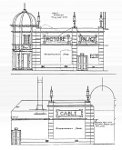
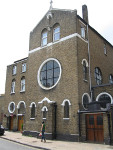 [5] In 1901 Lithuanian Catholics established a temporary church at 101-105 Cable Street
(on the
corner of Christian Street) - see here
for a comment about their settlement in the area around Planet Street.
The diocesan authorities assumed that the Polish church would suffice
for their needs (since Mass was in Latin anyway), but they continued to
press for their own church and when they came one Sunday to Mass with
sticks and cudgels the message got through. They moved to their present
site at The
Oval, Hackney Road in Bethnal Green in 1912 [right], and the site became Cable Picture Palace
(1913 to its bombing in 1940), with 350 seats on a single floor. H.
Percy Adams FRIBA was the architect - he was an advocate of simplicity,
appreciating the quality of plain brick or stone walls, and is
remembered for the King Edward VII Sanatorium [sic] at Midhurst in
Kent, and the Royal Victoria Infirmary in Newcastle-upon-Tyne; his
partner, with whom he worked on many projects, was Charles Holden
(famous for his tube station designs). The cinema's proprietor in 1915
was Samuel Wassersug, who was found guilty of receiving stolen
property. It was much-loved, but a real flea-pit (disinfected with
perfumed spray between performances) with hard seating, and was run on
a shoe-string. It continued to show silent films, with accompaniment
from a solitary pianist of limited repertoire, when most other
picture-houses had installed facilities for sound.
[5] In 1901 Lithuanian Catholics established a temporary church at 101-105 Cable Street
(on the
corner of Christian Street) - see here
for a comment about their settlement in the area around Planet Street.
The diocesan authorities assumed that the Polish church would suffice
for their needs (since Mass was in Latin anyway), but they continued to
press for their own church and when they came one Sunday to Mass with
sticks and cudgels the message got through. They moved to their present
site at The
Oval, Hackney Road in Bethnal Green in 1912 [right], and the site became Cable Picture Palace
(1913 to its bombing in 1940), with 350 seats on a single floor. H.
Percy Adams FRIBA was the architect - he was an advocate of simplicity,
appreciating the quality of plain brick or stone walls, and is
remembered for the King Edward VII Sanatorium [sic] at Midhurst in
Kent, and the Royal Victoria Infirmary in Newcastle-upon-Tyne; his
partner, with whom he worked on many projects, was Charles Holden
(famous for his tube station designs). The cinema's proprietor in 1915
was Samuel Wassersug, who was found guilty of receiving stolen
property. It was much-loved, but a real flea-pit (disinfected with
perfumed spray between performances) with hard seating, and was run on
a shoe-string. It continued to show silent films, with accompaniment
from a solitary pianist of limited repertoire, when most other
picture-houses had installed facilities for sound.
[6] Edward
Sells (1721/2-1793) was a lighterman, and astutely specialised in coal,
establishing his company at 49 Bankside (on the south of the Thames) in
1755. Although the price of coal fell in the 1820s, and further in the
1830s when the government succeeded in dismantling the complex and
archaic monopoly system, introducing sale by weight rather than by the
'chaldron measure' (based on estimates by underpaid, and therefore
bribeable, officials), it remained highly profitable, not least because
of the advent of gas lighting - hence the building of the now-iconic
power station at Bankside. By the 1830s, the firm was Jones and Sells
Coal Company, run by bachelor Vincent Sells and his brother Edward
Perronet Sells; the area was unhealthy, until it was later drained, so
Vincent moved away (but remained closely involved with the restoration
of St Saviour's Church) and the Bankside house was let to their clerk,
but it remained the company's address for some years until it was let
to a scrap metal dealer in 1860. 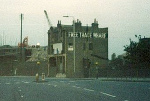 In 1856 they amalgamated as Wright,
Sells, Dale and Surtees, but when Wright died 3 years later a further
merger took place with their South Bank neighbours Charringtons, who
had become prominent in opening up trade in soft Welsh coal from the
Rhondda. Charrington, Sells, Dale & Co. continued
as a market leader for 60 years, with their main office and depot at
Charrington's [later Free Trade] Wharf, 2 Broad Street, Ratcliff [now
The Highway] - right in 1978 before demolition.
In 1856 they amalgamated as Wright,
Sells, Dale and Surtees, but when Wright died 3 years later a further
merger took place with their South Bank neighbours Charringtons, who
had become prominent in opening up trade in soft Welsh coal from the
Rhondda. Charrington, Sells, Dale & Co. continued
as a market leader for 60 years, with their main office and depot at
Charrington's [later Free Trade] Wharf, 2 Broad Street, Ratcliff [now
The Highway] - right in 1978 before demolition.
 In
1894 John Charrington senior dropped out of the partnership, which was
continued by Edward Perrenot Sells junior, Hylton William Dale and John
Charrington junior. See here for an 1898 Old Bailey case where various employees were accused of the theft of coal. Left is their Cable Street depot on Goad's 1899 insurance map, showing the various coal shoots [chutes].
In
1894 John Charrington senior dropped out of the partnership, which was
continued by Edward Perrenot Sells junior, Hylton William Dale and John
Charrington junior. See here for an 1898 Old Bailey case where various employees were accused of the theft of coal. Left is their Cable Street depot on Goad's 1899 insurance map, showing the various coal shoots [chutes].
They had their own railway wagons (copied by Hornby Dublo for model railwayers - right); a High Court case Charrington v. London & North Western Railway [1905] 2 KB 437
about 'demurrage' laid down precedents for what might be
'reasonable' in terms of delay and compensation for railway traffic.  The company is mentioned in John Betjeman's poem Parliament Hill Fields which described a young boy's tram ride [the number 7 route?] in 1912 or1913 from Charrington's offices at Gospel Oak station (where there was a request stop - 'stop here if required' - outside) to Highgate. It includes the couplet
The company is mentioned in John Betjeman's poem Parliament Hill Fields which described a young boy's tram ride [the number 7 route?] in 1912 or1913 from Charrington's offices at Gospel Oak station (where there was a request stop - 'stop here if required' - outside) to Highgate. It includes the couplet
In 1922 it became Charrington, Gardner, Locket & Co Ltd, with Mr Horne
as director (he was Mayor of Greenwich in 1922-23, and served on the
Metroplitan Standing Joint Committee, the Ministry of Transport's
Departmental Committee on Traffic Signs, and the Coal Trade Benevolent
Association). See Elspet Fraser-Stephen Two centuries in the London coal trade - the story of Charringtons (privately printed 1952). Their main depot was at Free Trade Wharf - 2 Broad Street, Ratcliff [now The Highway] - right in 1978 before demolition. In correspondence in the Iron & Steel Institute Journal
of 1919, they commented on the shortage of beehive coke - only
available from three works in County Durham - which foundries preferred
for casting work and hoped they would not adopt the making of patent
oven coke. They then added these curious remarks about smokeless fuel,
which was being promoted as a means of abating London's horrendous 'pea
souper' smogs:
| With regard to smokeless fuel caution was to be recommended, for the total demand for a fuel of that class in London for domestic purposes was only about 5000 tons, and a good deal of that would merely replace coke. To increase that quantity it would be necessary to reconstruct or build new fireplaces to burn the fuel vertically instead of horizontally, as there was a tendency of such fires to collapse suddenly and so go out. Further, modern houses (such as in garden suburbs) had no adequate provision for the storage of fuel, and most of the new houses could only take ½ ton of coal at a time. If they took smokeless fuel they could only take 5 cwt. - a great inconvenience. A smokeless fuel was not a pleasant combustible unless wood or coal was burned with it in considerable quantities. |
In
1923 it was reported that the Tyne-Tees Shipping Company Limited had
acquired Charrington's coal wharf adjoining the Free Trade Wharf:
| The property has an area of some 45,000 superficial feet, and, extending as it does from the river to Broad-street, has a depth of 280 ft. and a frontage to the river of 200 ft. A large contract has been secured by the well-known firm of constructional engineers. Brims & Co., Limited, Newcastle and Westminster, for the work of building new jetties and making the road-ways at the riverside. The scheme, which will necessitate the employment of a large number of men, includes two jetties consisting of timber piles. One jetty will be 220 ft. long by 15 ft wide, and will be connected by a 20-ft. roadway to the second jetty, which will be I50 ft. by 30 ft. It is also proposed to construct another road from the jetties to the Free Trade wharf, in order to facilitate the communication with the warehouses on the latter. On the outer jetty, the Hydraulic Engineering Company, Limited, of Chester and London, will put up three hydraulic pedestal cranes, each double-powered, and capable of lifting 30-40 cwt through a height of 90 ft at any rake. The maximum lift will be 123 ft., while the maximum and minimum rakes will be 85 ft. and 20 ft. respectively. The warehouses are expected to be ready for goods within a few months. |
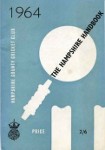
 [7] Harris Pepperberg (c1879-1952) was born
in Russia; he married Sarah (1878-1948) and their first child Marks
(Max Lewis) was born in Poland; they came to London and had five more
children, Eva, Engel (Issy), David, Joseph and Philip. He lived in
Cable Street until his death - the children, all of whom married,
moved to suburbs north and south (some shortening their name to
Pepper). Harris worked as a costume maker, in due course in
partnership with Engel as 'H & E Pepperberg, Mantle
Manufacturers', until a bankruptcy in 1940. In 1933 Engel, Joseph and Philip set up
as advertising and publicity agents and contractors &c as
'Pepper Publicity Ltd', with £100 capital in £1 shares, but it was
dissolved three years later. However, Max may have taken on some of
their business, as M.L. Pepper (Publicity) Ltd, of Harrow; in 1952 he
published the first yearbook of the National Amateur Tobacco Growers'
Association, and its other material (it was based in Harrow, but coincidentally its first president was Hugh Cuthbertson, later of St Paul Dock Street) and yearbooks for country cricket teams (Gloucester, Hampshire, Surrey - examples right); after his
death in 1963 the firm moved to Chelmsford.
[7] Harris Pepperberg (c1879-1952) was born
in Russia; he married Sarah (1878-1948) and their first child Marks
(Max Lewis) was born in Poland; they came to London and had five more
children, Eva, Engel (Issy), David, Joseph and Philip. He lived in
Cable Street until his death - the children, all of whom married,
moved to suburbs north and south (some shortening their name to
Pepper). Harris worked as a costume maker, in due course in
partnership with Engel as 'H & E Pepperberg, Mantle
Manufacturers', until a bankruptcy in 1940. In 1933 Engel, Joseph and Philip set up
as advertising and publicity agents and contractors &c as
'Pepper Publicity Ltd', with £100 capital in £1 shares, but it was
dissolved three years later. However, Max may have taken on some of
their business, as M.L. Pepper (Publicity) Ltd, of Harrow; in 1952 he
published the first yearbook of the National Amateur Tobacco Growers'
Association, and its other material (it was based in Harrow, but coincidentally its first president was Hugh Cuthbertson, later of St Paul Dock Street) and yearbooks for country cricket teams (Gloucester, Hampshire, Surrey - examples right); after his
death in 1963 the firm moved to Chelmsford.
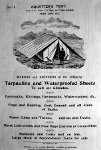
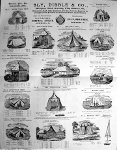


 [8] The origins of Sly, Dibble & Co were in a half-timbered house in Jewin Street, where by the start of the 19th century ancestors were sailmakers. In Kelly's Directory for 1875 they were listed as sail
makers & ship chandlers, manufacturers of improved railway sheets
& dressed waterproof cloths of every description suitable for all
climates, marquees, tents, flags, rick cloths, ropes & lines,
hop-pocketting, cart grease &c. &c. Tarpaulins, sacks &
bags on sale or hire, 1-6 Cornwall-st, London, E. [an earlier address for the Cable Street premises] & 15 Duke-st, London Bridge S.E. Temporary rooms fitted up; marquees, tents & flags on hire. Other advertisements specified all kinds of new and second hand sacks for lime, cement and plaster, and another, mysteriously, loin cloths and nose bags.
The partners were Richard Stevens Sly, John George Dibble and Alfred
Stone, but Stone resigned. In 1895 J.G. Dibble was appointed a member
of a committee investigating the winding-up of Reliance Portland Cement
Works Ltd. Left is their 1896 catalogue of tents, and right a
receipt of 1897 for linen, hessian and scrim, and Goad's 1899 insurance
map showing their premises between Cornwall and Cable Streets.
[8] The origins of Sly, Dibble & Co were in a half-timbered house in Jewin Street, where by the start of the 19th century ancestors were sailmakers. In Kelly's Directory for 1875 they were listed as sail
makers & ship chandlers, manufacturers of improved railway sheets
& dressed waterproof cloths of every description suitable for all
climates, marquees, tents, flags, rick cloths, ropes & lines,
hop-pocketting, cart grease &c. &c. Tarpaulins, sacks &
bags on sale or hire, 1-6 Cornwall-st, London, E. [an earlier address for the Cable Street premises] & 15 Duke-st, London Bridge S.E. Temporary rooms fitted up; marquees, tents & flags on hire. Other advertisements specified all kinds of new and second hand sacks for lime, cement and plaster, and another, mysteriously, loin cloths and nose bags.
The partners were Richard Stevens Sly, John George Dibble and Alfred
Stone, but Stone resigned. In 1895 J.G. Dibble was appointed a member
of a committee investigating the winding-up of Reliance Portland Cement
Works Ltd. Left is their 1896 catalogue of tents, and right a
receipt of 1897 for linen, hessian and scrim, and Goad's 1899 insurance
map showing their premises between Cornwall and Cable Streets.
 As
the company expanded - they had become government contractors - they
also diversified. Their 1891 trade catalogue (locally-printed by Dodsworths) describes them also as nurserymen & seedsmen dealing in horticultural and florists' sundries,
with premises at 2 Colonial Avenue, Minories as well as 209-213 Cable
Street [as it had now become], and 129 Commercial Street, Spitalfields.
The American Florist
of 1893 reported that A.G. Dibble visited Boston to drum up trade, and
at home they had a representative covering the Midlands, North,
Scotland (seeking a petition for cessio - surrender of goods - against James Lindsay of Glasgow in 1893) and Ireland. Right is
a presentation clock inscribed with the firm's name, from around 1920.
In 1923 they registered the freehold of 203-207 Cable Street; but also
in that year their share capital was reduced from £30,000 in £1 shares
to £20,000 in 10s. shares, of which only half were initially issued.
As
the company expanded - they had become government contractors - they
also diversified. Their 1891 trade catalogue (locally-printed by Dodsworths) describes them also as nurserymen & seedsmen dealing in horticultural and florists' sundries,
with premises at 2 Colonial Avenue, Minories as well as 209-213 Cable
Street [as it had now become], and 129 Commercial Street, Spitalfields.
The American Florist
of 1893 reported that A.G. Dibble visited Boston to drum up trade, and
at home they had a representative covering the Midlands, North,
Scotland (seeking a petition for cessio - surrender of goods - against James Lindsay of Glasgow in 1893) and Ireland. Right is
a presentation clock inscribed with the firm's name, from around 1920.
In 1923 they registered the freehold of 203-207 Cable Street; but also
in that year their share capital was reduced from £30,000 in £1 shares
to £20,000 in 10s. shares, of which only half were initially issued.
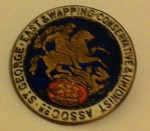 [9] St George's & Wapping Constitutional Club
- clubs so named were affiliated to the Conservative party, and
established all over the country towards the end of the 19th century,
providing social facilities, both for working- and middle-class areas.
Not all members were overtly political. (The gentlemen's club of this
name, founded in the wake of franchise reform, was in Northumberland
Avenue, off Trafalgar Square). 'St George's & Wapping' was the name
of the parliamentary constituency at this time. Until 1915, a few door along at no.235, was a Reform Club - affiliated to the Liberal Party. Left is a local association badge of this period.
[9] St George's & Wapping Constitutional Club
- clubs so named were affiliated to the Conservative party, and
established all over the country towards the end of the 19th century,
providing social facilities, both for working- and middle-class areas.
Not all members were overtly political. (The gentlemen's club of this
name, founded in the wake of franchise reform, was in Northumberland
Avenue, off Trafalgar Square). 'St George's & Wapping' was the name
of the parliamentary constituency at this time. Until 1915, a few door along at no.235, was a Reform Club - affiliated to the Liberal Party. Left is a local association badge of this period.
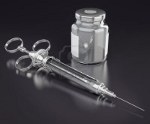
 [10] Vaccination against smallpox was regulated by a series of Vaccination Acts
from 1840 to 1907 (all repealed by the 1946 National Health Service
Act). The older practice of variolation (giving a controlled infection)
was banned, and compulsory vaccination of infants came in 1867, with
much debate over the years about penalties and provision for conscientious objection
(which initially involved a complex process so was rarely taken up). Initially poor law
guardians controlled the administration and paid the fees, but in 1871
the office of vaccination officer
was created. Many areas, however, failed to make appointments, or
combined it with that of relieving officer, and in some cases registrar
of births and deaths. See further Deborah Brunton The Politics of Vaccination: Practice and Policy in England, Wales, Ireland, and Scotland, 1800-1874
(2008).
[10] Vaccination against smallpox was regulated by a series of Vaccination Acts
from 1840 to 1907 (all repealed by the 1946 National Health Service
Act). The older practice of variolation (giving a controlled infection)
was banned, and compulsory vaccination of infants came in 1867, with
much debate over the years about penalties and provision for conscientious objection
(which initially involved a complex process so was rarely taken up). Initially poor law
guardians controlled the administration and paid the fees, but in 1871
the office of vaccination officer
was created. Many areas, however, failed to make appointments, or
combined it with that of relieving officer, and in some cases registrar
of births and deaths. See further Deborah Brunton The Politics of Vaccination: Practice and Policy in England, Wales, Ireland, and Scotland, 1800-1874
(2008).
Benjamin's
father William had a clock- and watch-making business at 291 Cable
Street (formerly 12 Wellington Place, Back Road) from around 1850-1901;
Benjamin gave this up when he became Vaccination Officer; the family
moved to Ilford, but maintained links with St George-in-the-East, where
his son Gurner Prince Jones (born in 1885) was a lieutenant in the Church Lads' Brigade for St George's
and St Peter's. Gurner spent most of
his working life, apart from the First World War, in Stepney's library
service, and was Borough Librarian from 1936 until his retirement ten
years later (succeeding Albert Cawthorne, who had held the post for 34
years following the creation of the Borough of Stepney and the merger
of its libraries). He was a part-time graduate of the East London
College (founded in 1902, becoming Queen Mary College in 1907 and part
of the University of London) - which was just around the corner from
his base at the Bancroft Road library: he was one of the few pre-World
War II municipal librarians to have become a graduate by part-time study, and was Honorary
Secretary of the Association of Assistant Librarians from 1920 (in
which year be became Chief Assistant), and President in 1931-32 (having
become Deputy Borough Librarian in 1929). After his retirement, he
commented that those who like him had served in the First World War returned in a somewhat revolutionary frame of mind, very unsettled,
somewhat disgruntled, and determined to see that the bad old days
should be abolished and a new era inaugurated.
During
the Second World War he was Chief Food Officer for Stepney, reponsible
for administering food rationing in the borough - so may well have
clashed with Fr Groser
when be broke open a food store in 1940. (He was upset that his deputy
as Chief Librarian was not paid for the extra duties he took on.) The
overwork of this period led him to take retirement at 60 rather than
continuing to 65; the family moved to Swanage, and he died there in
1960.
His son Peter was made a Companion of the Order of the Bath (CB) in 1991 for his work with the Inland Revenue, and we are grateful to his for information about his father and grandfather.
[10b] formerly the premises of the New Liberal Working Men's Club and Institute, a friendly society
(no.1082) set up in 1906 but dissolved in 1915 - one of a number of
such societies which came to an end during the war years. In 1917 the
Carnegie Trust reported on the Physical Welfare of Mothers and Children
trhoughout the land, and listed activities at these premises, along
with those at the Congregational Chapel, Watney Street; St
George's Mission Hall; Planet Street Institute; the Wesleyan
Chapel in Cable Street; and St Mary's Mission Hall, Johnson Street.
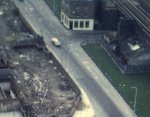 [11] As this picture shows, the Cable Street sub-post office
was among the last building to be cleared from Cable Street in the
1980s. In 1910 George Vincent was acquitted of a postal order fraud
(despite having 'form' for similar offences), including one for 8/-
purporting to be from this office; the postmistress Cecilia Sarah
Montford gave evidence that it was falsely stamped.
[11] As this picture shows, the Cable Street sub-post office
was among the last building to be cleared from Cable Street in the
1980s. In 1910 George Vincent was acquitted of a postal order fraud
(despite having 'form' for similar offences), including one for 8/-
purporting to be from this office; the postmistress Cecilia Sarah
Montford gave evidence that it was falsely stamped.
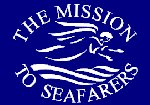 [12] Alongside the various local institutions for seafarers,
in 1856 the Church of England established the Missions to Seamen with
hostels and institutes all around the world, offering
accommodation, recreation and spiritual and practical help. In 1919
they ran the following institutes in Docklands: 6 Cable Street (for men
only); 154 East India Dock Road (for officers only; about 1/-;
literature, billiards), Victoria Dock Road, Custom House E16 (for
officers and men; billiards); Tilbury Docks (35 cubicles at 1/- per
night and 5/- per week, billiards and other games, concerts during
winter months). Renamed the Mission to Seafarers
in 2000, its headquarters are at St Michael Paternoster Royal in the
City. The flying angel symbol comes from Revelation 14.16.
[12] Alongside the various local institutions for seafarers,
in 1856 the Church of England established the Missions to Seamen with
hostels and institutes all around the world, offering
accommodation, recreation and spiritual and practical help. In 1919
they ran the following institutes in Docklands: 6 Cable Street (for men
only); 154 East India Dock Road (for officers only; about 1/-;
literature, billiards), Victoria Dock Road, Custom House E16 (for
officers and men; billiards); Tilbury Docks (35 cubicles at 1/- per
night and 5/- per week, billiards and other games, concerts during
winter months). Renamed the Mission to Seafarers
in 2000, its headquarters are at St Michael Paternoster Royal in the
City. The flying angel symbol comes from Revelation 14.16.

 [13] Barnett Bomzer (Bomze) (1880-1935), from Poland, tobacconist & hairdresser, was naturalized in 1924; his wife was Augusta.
[13] Barnett Bomzer (Bomze) (1880-1935), from Poland, tobacconist & hairdresser, was naturalized in 1924; his wife was Augusta.
[14] The Horse & Horseshoe's address was formerly no.3; it closed as a pub in 1997 [right in 1987 and 2007].
[15] The Bricklayers Arms' address was formerly no.10.
[16] Bernard Nordheim was the
third of four children of Cecilia Nordheim (1820-1906), they were born
in Prussia, and established a bakery business in Oxford Street, Mile
End, with several local shops. In 1905 Bernard hit the headlines;
according to Lloyd's Weekly
| DEAD FROM OVERWORK - A BAKER'S LONG HOURS Tho East London coroner held an inquiry at Stepney recently concerning the death of Henry Frederick Sautter, aged 41, a journeyman baker, late of 23, Clive-street, Mile-end, who died from the effects of overwork. Emma Sautter stated that the deceased was her husband, who for the last three weeks had suffered from shortness of breath. On Monday last he left home at night to work at Mr Nordheim's in Oxford-street. Shortly after madnight she was sent for, and found him lying dead in the bakehouse. He had complained of being overworked for some time past. On Fridays he had worked from 7 p.m. until 9 p.m. on the Saturday, and every other Sunday 9 o'clock in the morning until 1.30 baking dinners. The Coroner: They must have done a big business; are these hours usual ?— Witness: Mr Nordheim had four shops to keep going, but this is the only bake-house. Witness added that the deceased was not a union man. Sometimes he got 2s. extra, and then his master wanted to stop the allowance of a loaf. Deceased continued working because they had five children, and he didn't know where else he might get employment. His wages were 32s. a week. George Aitcholer, of Durban-road, West Ham, said he was the foreman baker. Deceased started work at nine p.m. and appeared in his usual health. About 11 p.m. he had some fried fish, and started work again. Shortly afterwards he fell forward on his face and expired. Witness had noticed the deceased beating his chest with his hands twice during the night. Witness had been away ill himself for three months. A Juror: That is not surprising. What are your actual hours ? — Witness: We start at 9 p.m. and loave off at noon the next day. On Saturdays the hours are longer still. They got their meals the best way they could whilst the bread was in the oven. ('Shame!' from the jury.) Deceased had frequently complained of too much work. Ten hours was the union time. A Juror: This man has been putting in about 15 hours every day except Saturdays, and then he put in about 23. William Bick, a fellow worker of deceased, said there were four men at work, and they could often do with more hands. Witness had been working l5 hours a day and 23 on Saturdays, and six hours on Sunday. Sometimes on Saturdays they had to wait three hours for their money (sensation). The Coroner: I thought 48 hours a week was the average for the working man, but you seem to get in nearly all in a few days. In reply to questions witness said they had all complained. There was a dusthole in the bakehouse, and they had to put some sacks up to keep the rain out. Witness had belonged to the union, but had 'chucked it' as the contributions were too much. Bernard Nordheim, tbe proprietor, of 256, Oxford-street, E., gave evidence, and in reply to the coroner, said the men's hours 'varied'. They had a rest and went to sleep inside the troughs.— The Coroner: You don't provide couches? You don't employ union men, do you? Witness: I don't study the point; they are mixed. Witness added that the bakehouse was large and lofty. (A voice: 'Rot!') Dr John Normile deposed that having heard the evidence and the history of the case, he was satisfied that the deceased had died from heart failure accelerated by overwork and long hours. The coroner remarked that there was no doubt about too long hours and the jury returned a verdict in accordance with the medical testimony. |
[17] Blakeney's Head
(previously no.25) was also known as Admiral Blakeney's Head. William
Blakeney (1672-1761) led the defence of Minorca in 1756 during the
Seven Years' War, eventually forced to surrender on honourable terms to
the French. 84 years old at the time, he is said not to have taken to
his bed during seventy days' fighting. The pub featured in Peter Love's
2009 novel Ambidexterity.
[18] Abraham Sugar was born in Zborov, Poland in 1879; he married Rachel Marks and had 9 children. He died in Leeds in 1944.
[19] Cap
making
was a specific tailoring skill. In the previous century, they made
night caps, morning caps, dress caps and widow's caps for women, cloth
caps and uniform caps for men, and fancy caps for boys. A study of the 19th
century Jewish cap makers of Whitechapel is here.
[20] The Blue Anchor was previously numbered 35.
[21] The Magpie & Stump's original address was 7 New Road, when parts of Cable Street were so numbered.
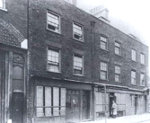 [22] In 1888 this had been the address of Severin
Klosowski, known as George Chapman, a Polish barber who was convicted
of serial wife poisoning and executed in 1903; he has been considered
as a candidate for Jack the Ripper, though his methods were very
diferent. The premises (boarded up) are shown in 1943.
[22] In 1888 this had been the address of Severin
Klosowski, known as George Chapman, a Polish barber who was convicted
of serial wife poisoning and executed in 1903; he has been considered
as a candidate for Jack the Ripper, though his methods were very
diferent. The premises (boarded up) are shown in 1943.
[23] The funeral directors W. English & Son were established in 1880; they remain in business, as part of the Dignity group, and have premises in Bethnal Green and South Woodford.
[24]
Jacob Bonallack came from Cornwall to London in 1825 to build horse
wagons, which became renowned for their quality and were exported all
around the world. In 1846 he went into partnership with Joseph Briggs
as coach makers and coach and cart wheelwrights,
at Hanbury's Field, Brick Lane, with a shop in John Street and a shop
and counting house in Church Lane; Briggs became an insolvent debtor
(as was common with wheelwrights and coachbuilders - few survived for
more than ten years). The Engineer & Machinist's 1850 list of 'registered designs for articles of utility' includes Jacob Bonallack, of Whitechapel and Holloway, for staves and stays for vans and cart bodies. In 1869 he was living at 67 Church Street, Whitechapel, and was one of 19 signatories to a lease on the vaults under the Brick Lane chapel,
then in Methodist hands - being Cornish, presumably he was a Methodist?
(The National Sunday School Union in 1874 lists his grandson William
John as Superintendent at Whitechapel.) 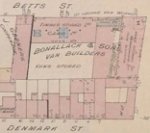
 That same year, Jacob left
the partnership, handing over the running of
the business to his grandsons William John and Walter, as Bonallack & Sons, wheelwrights, of 149 Cable Street [the 1878 Vestry map, right, also shows premises on the other side of the road; far right are
their premises, between Betts and Denmark Street, in Goad's 1899
insurance map). Jacob was then in partnership with James George Manning
as Sheffield Ware Fancy & General Dealers
at 107 Mile End Road, but this was dissolved in 1871 and Frederick
Jacob Bonallack stepped in; by the end of the century he was a fancy
goods importer, with shops in Sydenham, West Norwood, Bromley and South
Norwood, but went bust in 1904.
That same year, Jacob left
the partnership, handing over the running of
the business to his grandsons William John and Walter, as Bonallack & Sons, wheelwrights, of 149 Cable Street [the 1878 Vestry map, right, also shows premises on the other side of the road; far right are
their premises, between Betts and Denmark Street, in Goad's 1899
insurance map). Jacob was then in partnership with James George Manning
as Sheffield Ware Fancy & General Dealers
at 107 Mile End Road, but this was dissolved in 1871 and Frederick
Jacob Bonallack stepped in; by the end of the century he was a fancy
goods importer, with shops in Sydenham, West Norwood, Bromley and South
Norwood, but went bust in 1904.
Meanwhile,
in 1886 Bonallack & Sons had taken over Stephen Gowar & Co, a
long-established coachbuilding firm in Stratford, and in 1891 Walter
bought out his brother William John. They were now van builders, wheelwrights & contractors, of Cable St and The Broadway, Stratford, making motor vehicle bodies. By 1921, Who's Who in Engineering records that Walter's co-directors were Francis and John; they had four branches, and produced commercial motor bodies to any design, horse-drawn vehicles, artillery and plain wheels and wheel components, motor roofing. They moved their factory to Nursery Lane, Forest Gate, and had a showroom in Romford Road. In 1927 the Municipal Journal & Public Works Engineer (vol 36, p164) describes one of their specialist vehicles:
| This ambulance Is the direct result of considerable war-time experience on the part of the senior partner in the firm, Mr. Walter Bonallack, M.I.A.E., and embraces features not to be found in other ambulances on the market. The loading arrangements include a sliding stretcher frame which enables a patient to be loaded without first lowering the stretcher into the roadway, as is the case with the standard type of vehicle. The rear doors also are the full depth of the vehicle, and are so constructed that they shut right back against the side of the vehicle, leaving an absolutely undisturbed loading way. This is a convenience which will be appreciated by every ambulance man.Another special feature of the ambulance is the panelling, which is constructed of a jointless composition specially designed to withstand both sound and changes of temperature. It will be readily appreciated that this feature is an immense comfort to very sick people for whom the exclusion of noise coupled with even temperature means a very gret deal. The internal equipment includes two stretcher carriers, one long seat for sitting cases, a large locker for appliances, and a handsome mahogany fall down washing cabinet with water reservoir. It should also be mentioned that the mahogany-lined interior is finished in white enamel, and that all joints, mouldings, &c., likely to harbour dust or germs have been eliminated. The driver's compartment is very comfortably upholstered with spring cushions, &c, so that both the driver and attendant are able to travel quite as comfortably as in an average touring car. The whole vehicle is painted in the standard colours of the Dagenham Council, a deep cream embellished with the Council's coat of arms, and suitable lettering. the general effect is very pleasing.The chassis on which this ambulance is mounted is the well-known Morris ton chassis, with special additions to the spring suspension to render it smooth and easy running for ambulance purposes. Tho general combination between the Morris chassis and the body certainly represents an alliance between one of the most go-ahead chassis builders and also one of the oldest and best-known body builders in the country. |

 This
blog tells how in 1938 the volunteer fire brigade at Borough Green in
Kent bought a 1921 Rolls Royce Silver Ghost for £26 from press baron
Lord Kelmsley, and Walter Bonallack (who had a house in the village)
converted it for their use; it became Matchbox 'model of yesteryear no
Y-6 [left]. In 1951 they made an experimental 3-wheeler car, the Bonallack Minnow [left].
Powered by a 250cc Excelsior Talisman twin cylinder 2-stroke engine, it
had a vertical windscreen, a front seat bench and a convertible hood
and side curtains, but it was not a success and production ceased the
following year.
This
blog tells how in 1938 the volunteer fire brigade at Borough Green in
Kent bought a 1921 Rolls Royce Silver Ghost for £26 from press baron
Lord Kelmsley, and Walter Bonallack (who had a house in the village)
converted it for their use; it became Matchbox 'model of yesteryear no
Y-6 [left]. In 1951 they made an experimental 3-wheeler car, the Bonallack Minnow [left].
Powered by a 250cc Excelsior Talisman twin cylinder 2-stroke engine, it
had a vertical windscreen, a front seat bench and a convertible hood
and side curtains, but it was not a success and production ceased the
following year.
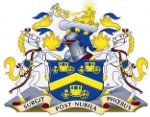
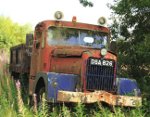
 The next year they moved to a new factory in Basildon. Here they made specialist bodies, including fire tenders, refrigerated
vans, ambulances, outside
broadcast vans, ice cream vans, and took out several patents. An
example of one of their conversions is shown left - a former US Army vehicle converted into a snowplough for Aberdeenshire County Council. Right is an Armstrong Siddeley Eighteen chassis with custom-built shooting brake/utility coachwork. There
are still a few who remember 'Mr Walter', who was a member of the Worshipful Company of Coachmakers
(whose founding predates its present charter of 1688, and in recent
years has moved from quality control of coachbuilding to supporting
both the heritage craft and contemporary trade developments in the
aerospace, automotive and rail industries - arms right).
He died in 1961, aged 90; his son Basil became chairman of the company.
In 1963 they formed a new company, Bonallack Mann Egerton (Refrigerated
Vehicles) Ltd., and in 1971 they merged with Freight Development
Company as Freight Bonallack Ltd, part of the Alcan Group of companies
(originally James Booth Aluminium Ltd), with Sir Richard Bonallack
(1904-96), described as a mechanical engineer,
as chairman, running divisions in Basildon, Lancing, Norwich and
Wakefield. It became known as Alcan Transport Products, but reverted to
the Freight Bonallack name in 1985 following further company
restructuring. They were involved in container trade exchanges around
Europe, including Russia.
The next year they moved to a new factory in Basildon. Here they made specialist bodies, including fire tenders, refrigerated
vans, ambulances, outside
broadcast vans, ice cream vans, and took out several patents. An
example of one of their conversions is shown left - a former US Army vehicle converted into a snowplough for Aberdeenshire County Council. Right is an Armstrong Siddeley Eighteen chassis with custom-built shooting brake/utility coachwork. There
are still a few who remember 'Mr Walter', who was a member of the Worshipful Company of Coachmakers
(whose founding predates its present charter of 1688, and in recent
years has moved from quality control of coachbuilding to supporting
both the heritage craft and contemporary trade developments in the
aerospace, automotive and rail industries - arms right).
He died in 1961, aged 90; his son Basil became chairman of the company.
In 1963 they formed a new company, Bonallack Mann Egerton (Refrigerated
Vehicles) Ltd., and in 1971 they merged with Freight Development
Company as Freight Bonallack Ltd, part of the Alcan Group of companies
(originally James Booth Aluminium Ltd), with Sir Richard Bonallack
(1904-96), described as a mechanical engineer,
as chairman, running divisions in Basildon, Lancing, Norwich and
Wakefield. It became known as Alcan Transport Products, but reverted to
the Freight Bonallack name in 1985 following further company
restructuring. They were involved in container trade exchanges around
Europe, including Russia.
The family lived at Thorpe Bay in Essex and Sir Richard was active in
the development of Basildon New Town. A keen golfer, present when a new
course was opened there in 1967, his son Sir Michael Bonallack
OBE was the most prominent amateur golfer of his generation, winner of
five British Amateur and five English Amateur championships, and nine
times a Walker Cup player.
[25] Flatau
is a Polish/Russian Jewish name; Fred, born in Russia, was naturalized
in 1899. His family is currently researching his history
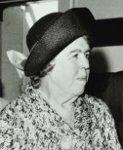 [26] According to the archives of the Royal London Hospital, where its records are kept, the East London Nursing Society
was established in 1868 to provide trained nurses for the 'sick poor'
in their own homes in East London. One of its founders was the Hon. Mrs Jane Stuart-Wortley. Three private nurses were initially
engaged to work in Bromley, Poplar and St Philips, Stepney Way. The
Society merged with the Metropolitan and National Association for
Providing Trained Nurses for the Sick Poor (formed in 1874), becoming
its Eastern Division; but in 1881 the East End Branch assumed its
original, independent position. Princess Christian became President of
the Society in 1883, and in 1891 the Society became affiliated with
Queen Victoria's Jubilee Institute for Nurses. From 1912 the Society's
nurses began to attend the School Centre in Poplar. The London County
Council and Borough Councils increasingly supported the Society's work,
and in 1943 the LCC asked the Society to take responsibility for
District midwifery training in the area. See The History of a Hundred Years: East London Nursing Society 1868-1968. by Edith Ramsay MBE [right] who was a
key figure in local nursing and other affairs; sheltered
housing in Duckett Street is named after her, and she figured in Fr Joe Williamson's slum
clearance campaigns and in a 1970 documentary about the Battle of Cable Street. The ELNS continues - a member of our congregation
is one of its trustees.
[26] According to the archives of the Royal London Hospital, where its records are kept, the East London Nursing Society
was established in 1868 to provide trained nurses for the 'sick poor'
in their own homes in East London. One of its founders was the Hon. Mrs Jane Stuart-Wortley. Three private nurses were initially
engaged to work in Bromley, Poplar and St Philips, Stepney Way. The
Society merged with the Metropolitan and National Association for
Providing Trained Nurses for the Sick Poor (formed in 1874), becoming
its Eastern Division; but in 1881 the East End Branch assumed its
original, independent position. Princess Christian became President of
the Society in 1883, and in 1891 the Society became affiliated with
Queen Victoria's Jubilee Institute for Nurses. From 1912 the Society's
nurses began to attend the School Centre in Poplar. The London County
Council and Borough Councils increasingly supported the Society's work,
and in 1943 the LCC asked the Society to take responsibility for
District midwifery training in the area. See The History of a Hundred Years: East London Nursing Society 1868-1968. by Edith Ramsay MBE [right] who was a
key figure in local nursing and other affairs; sheltered
housing in Duckett Street is named after her, and she figured in Fr Joe Williamson's slum
clearance campaigns and in a 1970 documentary about the Battle of Cable Street. The ELNS continues - a member of our congregation
is one of its trustees.
[27] The Chapman Estate office
had a builders' yard behind, in what is now Hawksmoor Mews. One of the
staff there was Harry Costin, born at 197 Cable Street in 1895; he
lived with his parents in Tait Street, and served with the Royal
Fusiliers in the First World War - his eyesight was affected by mustard
gas. He married Lillian Newman at St George's in 1923, and later worked
as a security officer for Bonallack
and for Truman's Breweries on the corner of Cable and Betts Street; he
died in 1974. Another was William Whiting, father of the late Edith Wyeth.
The estate manager in the early years of the century was Walter
Belcher, who was also a Stepney Borough Councillor, and gave evidence
in favour of immigration controls to the 1903 Royal Commission on Alien
Immigration (which led to the 1905 Aliens Act). Like others, he conflated issues of welfare with the 'Jewish problem'. More extremely, in Ichabod,
a nasty anti-semitic novel of 1910 by James Blyth (which advocated
deporting Jews to Mexico and Latin America) a character says Of
course there are two or three large estates, such as the Chapman
estate, the freehold of which the grasping vermin have been unable to
get. But even in those estates, they have, in many instances, managed
to secure a leasehold interest by dirty, underhand subterfuges .... See here for more on the Chapman estate and the Winterton family.
As Denys Munby thoroughly details in chapter 3 of his 1951 report Industry and Planning in Stepney,
in the inter-war years the large private landlords failed to match the
London County Council in terms of slum rebuilding, though in 1934 the
estate did build Turnour House. Hence Lord Winterton's comment to his biographer (Near to Greatness p188), referring to 1920 or so: Phyllis [Brooks - a close friend]
had some not very pleasant rumours to tell me emanating from social
workers on the condition of the Chapman Estate ... Chapman Estate
concert for women ... I got a very good reception at both
entertainments (concert for men in the evening), rather surprising for
an East End landlord in these days, especially as the Labour Mayor of
Stepney proposed my health amid acclamations. The area of the Chapman estate was badly blitzed and has since been more or less entirely rebuilt.
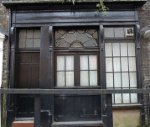
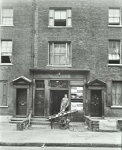 [28]
There is an honourable tradition in the East End of women running
businesses (as opposed to shops), though less commonly in their own
name, like Mrs Matilda Deppe, who provided what today would be called a car hire or minicab service. The last landlady of the Crown and Dolphin, on the corner of Cable Street and Cannon Street Road, was Jackie Deppe - what relation?
[28]
There is an honourable tradition in the East End of women running
businesses (as opposed to shops), though less commonly in their own
name, like Mrs Matilda Deppe, who provided what today would be called a car hire or minicab service. The last landlady of the Crown and Dolphin, on the corner of Cable Street and Cannon Street Road, was Jackie Deppe - what relation? [30] The Association of Infant Welfare and Maternity Centres, of which the Jewish Infants Welfare Centre was a branch, was founded in 1911. In 1926 the London Workers' Section of the Association resolved to beseech the Ministry of Health to remove the embargo on the giving of information on birth control at infant welfare centres by the medical officer in charge to cases when he or she considers it necessary, cleverly adding and draws the Ministry's attention to the danger of the indiscriminate sale of birth control literature and the display of contraceptives. The issue was debated in the House of Lords that year, churchmen and others voicing their opposition. (The Association changed its name to The Association of Maternity and Child Welfare Centres, and in 1938 amalgamated with the National Association for the Prevention of Infant Mortality (founded in 1906) as the National Association for Mother and Child Welfare.)
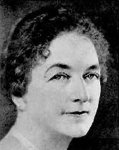
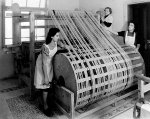
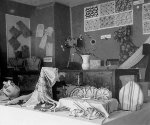 Henrietta
Irwell (c1870-1941), secretary of the Cable Street centre, was the
Chairman [sic] of the London Workers' Section. In 1922, having been
unable to chair the Association during a
campaigning trip to the USA, she entertained its members to a social afternoon in
Kew Gardens. Born Henrietta Fuerst in Germany, she was twice-widowed
and rich, living at 8f Bickenhall Mansions, Gloucester Place: she
married her second husband, Mecklenburg-born wool merchant Hermann
Irwell, in 1901; he was over 30 years older than her, and died in 1910.
She
was one of the leading Zionists of her generation, and a feminist. In
1905 she had endowed Alice Model's Jewish Day Nursery in Whitechapel,
enabling it to employ a kindergarten teacher, and in 1922 was a founder
member of the Council for the Amelioration of the Legal Position of
the Jewess. In 1918 she was involved in the creation of the Federation
of Women Zionists, which in 1920 became the Women's International
Zionist Organisation, of which she was co-treasurer and one of three
vice-presidents (Lady Beatrice Samuel was president). WIZO worked for
child welfare in Palestine, and its headquarters was named for her in
1936. She went to Australia and New Zealand (with her niece Miss
Forrester) to promote its work in 1929. She was also a council member
of the Jewish Health Organisation, an active supporter of the National
Institute of Industrial Psychology, and an elected member of the Royal
Asiatic Society, and helped finance the Ahad Ha'am Lectureship in
Modern Hebrew at the School of Oriental Studies (now SOAS). None of
this stopped her from spending the season in Cannes in 1937, staying at
the Grand Hotel! During the Nazi era she was active in fundraising for
German refugees. Right are
two WIZO projects in Haifa: the Henrietta Irwell School for Women's
Handicrafts, and the weaving department of the Henrietta Irwell
Professional School in Haifa.
Henrietta
Irwell (c1870-1941), secretary of the Cable Street centre, was the
Chairman [sic] of the London Workers' Section. In 1922, having been
unable to chair the Association during a
campaigning trip to the USA, she entertained its members to a social afternoon in
Kew Gardens. Born Henrietta Fuerst in Germany, she was twice-widowed
and rich, living at 8f Bickenhall Mansions, Gloucester Place: she
married her second husband, Mecklenburg-born wool merchant Hermann
Irwell, in 1901; he was over 30 years older than her, and died in 1910.
She
was one of the leading Zionists of her generation, and a feminist. In
1905 she had endowed Alice Model's Jewish Day Nursery in Whitechapel,
enabling it to employ a kindergarten teacher, and in 1922 was a founder
member of the Council for the Amelioration of the Legal Position of
the Jewess. In 1918 she was involved in the creation of the Federation
of Women Zionists, which in 1920 became the Women's International
Zionist Organisation, of which she was co-treasurer and one of three
vice-presidents (Lady Beatrice Samuel was president). WIZO worked for
child welfare in Palestine, and its headquarters was named for her in
1936. She went to Australia and New Zealand (with her niece Miss
Forrester) to promote its work in 1929. She was also a council member
of the Jewish Health Organisation, an active supporter of the National
Institute of Industrial Psychology, and an elected member of the Royal
Asiatic Society, and helped finance the Ahad Ha'am Lectureship in
Modern Hebrew at the School of Oriental Studies (now SOAS). None of
this stopped her from spending the season in Cannes in 1937, staying at
the Grand Hotel! During the Nazi era she was active in fundraising for
German refugees. Right are
two WIZO projects in Haifa: the Henrietta Irwell School for Women's
Handicrafts, and the weaving department of the Henrietta Irwell
Professional School in Haifa.
[31] Joseph Simon Hymans & Abraham Simon Hymans traded as rag, waste and general merchants under the name of the Albion Mills Company
from 56 Lochnagar St, Poplar, with other premises in Brighton Mills,
Heckmondwike and Albion Mills, Batley as well as Cable Street. (There
were spinning mills in Yorkshire and the north west with the same
company name.) The Ministry of Labour Gazette for 1920 reported proceedings under the 1896 Conciliation Act and associated statutes:
| Dock, Wharf, Riverside and General Workers' Union v. The Albion Mills
Company, General Merchants and Shippers, London. Difference — Application for a minimum wage and other working conditions. Agreement — Minimum rates of £3 10s. per week for males over the age of 19 and £1 I7s. 6d. for all females, with overtime at the rate of time and a half for all hours worked beyond the normal work day. The wage of piece workers to be 25 per cent, on the current rate. Working week should consist of 47 hours: other conditions fixed. Signed 22nd April 1920 [W.A. 2370] |
In
1919 they appointed Seymour S. Lappert & Co, paper stock (rag)
dealers of New York, to represent the company in the sale
of all papermakers' supplies which they exported to the
United States. In 1922 they sued an insurer for £30,000 on stock
destroyed by fire at a wharf. The claim failed because it was held to
be fraudulent, based on falsified stock books (Albion Mills Company v. H. Babington Hill (1922) 11 Ll.L.Rep. 54).
This was presumably what led the company into liquidation, with a
receiving order that same year and a final dividend of 3¼d. in the
£.
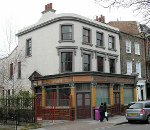 [32] At 232 Cable Street adjacent to Library Place, is the former Britannia Arms/Tavern [left],
a locally-listed building, a private dwelling since 1996 and carefully
restored in 2011, now offering bed and breakfast accommodation. (Not to be confused with The Britannia off Watney Street!)
[32] At 232 Cable Street adjacent to Library Place, is the former Britannia Arms/Tavern [left],
a locally-listed building, a private dwelling since 1996 and carefully
restored in 2011, now offering bed and breakfast accommodation. (Not to be confused with The Britannia off Watney Street!)
Back to Cable Street